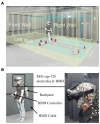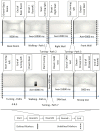Walking through Architectural Spaces: The Impact of Interior Forms on Human Brain Dynamics
- PMID: 29033807
- PMCID: PMC5627023
- DOI: 10.3389/fnhum.2017.00477
Walking through Architectural Spaces: The Impact of Interior Forms on Human Brain Dynamics
Abstract
Neuroarchitecture uses neuroscientific tools to better understand architectural design and its impact on human perception and subjective experience. The form or shape of the built environment is fundamental to architectural design, but not many studies have shown the impact of different forms on the inhabitants' emotions. This study investigated the neurophysiological correlates of different interior forms on the perceivers' affective state and the accompanying brain activity. To understand the impact of naturalistic three-dimensional (3D) architectural forms, it is essential to perceive forms from different perspectives. We computed clusters of form features extracted from pictures of residential interiors and constructed exemplary 3D room models based on and representing different formal clusters. To investigate human brain activity during 3D perception of architectural spaces, we used a mobile brain/body imaging (MoBI) approach recording the electroencephalogram (EEG) of participants while they naturally walk through different interior forms in virtual reality (VR). The results revealed a strong impact of curvature geometries on activity in the anterior cingulate cortex (ACC). Theta band activity in ACC correlated with specific feature types (rs (14) = 0.525, p = 0.037) and geometry (rs (14) = -0.579, p = 0.019), providing evidence for a role of this structure in processing architectural features beyond their emotional impact. The posterior cingulate cortex and the occipital lobe were involved in the perception of different room perspectives during the stroll through the rooms. This study sheds new light on the use of mobile EEG and VR in architectural studies and provides the opportunity to study human brain dynamics in participants that actively explore and realistically experience architectural spaces.
Keywords: EEG; HMD; architectural interior form; mobile brain/body imaging (MoBI); neuroarchitecture; virtual reality.
Figures






Similar articles
-
Neurophysiological correlates of embodiment and motivational factors during the perception of virtual architectural environments.Cogn Process. 2015 Sep;16 Suppl 1:425-9. doi: 10.1007/s10339-015-0725-6. Cogn Process. 2015. PMID: 26224275
-
Neuroarchitecture: How the Perception of Our Surroundings Impacts the Brain.Biology (Basel). 2024 Mar 28;13(4):220. doi: 10.3390/biology13040220. Biology (Basel). 2024. PMID: 38666832 Free PMC article. Review.
-
The impact of room shape on affective states, heartrate, and creative output.Heliyon. 2024 Mar 16;10(6):e28340. doi: 10.1016/j.heliyon.2024.e28340. eCollection 2024 Mar 30. Heliyon. 2024. PMID: 38545212 Free PMC article.
-
Effects of Changes to Architectural Elements on Human Relaxation-Arousal Responses: Based on VR and EEG.Int J Environ Res Public Health. 2021 Apr 19;18(8):4305. doi: 10.3390/ijerph18084305. Int J Environ Res Public Health. 2021. PMID: 33921601 Free PMC article.
-
The Cognitive-Emotional Design and Study of Architectural Space: A Scoping Review of Neuroarchitecture and Its Precursor Approaches.Sensors (Basel). 2021 Mar 21;21(6):2193. doi: 10.3390/s21062193. Sensors (Basel). 2021. PMID: 33801037 Free PMC article.
Cited by
-
Challenge for Affective Brain-Computer Interfaces: Non-stationary Spatio-spectral EEG Oscillations of Emotional Responses.Front Hum Neurosci. 2019 Oct 30;13:366. doi: 10.3389/fnhum.2019.00366. eCollection 2019. Front Hum Neurosci. 2019. PMID: 31736727 Free PMC article.
-
Mobile EEG in research on neurodevelopmental disorders: Opportunities and challenges.Dev Cogn Neurosci. 2019 Apr;36:100635. doi: 10.1016/j.dcn.2019.100635. Epub 2019 Mar 8. Dev Cogn Neurosci. 2019. PMID: 30877927 Free PMC article. Review.
-
Biophilic design, neuroarchitecture and therapeutic home environments: harnessing medicinal properties of intentionally-designed spaces to enhance digital health outcomes.Front Med (Lausanne). 2025 Jul 10;12:1610259. doi: 10.3389/fmed.2025.1610259. eCollection 2025. Front Med (Lausanne). 2025. PMID: 40708654 Free PMC article.
-
Effects of the Visual Character of Transitional Spaces on Human Stress Recovery in a Virtual Reality Environment.Int J Environ Res Public Health. 2022 Oct 12;19(20):13143. doi: 10.3390/ijerph192013143. Int J Environ Res Public Health. 2022. PMID: 36293723 Free PMC article. Clinical Trial.
-
Comparative Analysis of Restorative Interior Design Elements: Screen-Based Versus Virtual Reality Evaluations for Future Medical Treatment Prospects.Int J Environ Res Public Health. 2024 Dec 31;22(1):44. doi: 10.3390/ijerph22010044. Int J Environ Res Public Health. 2024. PMID: 39857497 Free PMC article.
References
-
- Ackerman J. S., Collins P., Gowans A. (2017). Architecture (Form) Encyclopædia Britannica. Edinburgh: Encyclopædia Britannica, Inc.
-
- Banaei M., Ahmadi A., Yazdanfar A. (2017). Application of AI methods in clustering of architecture interior forms. Front. Arch. Res. 6, 360–373. 10.1016/j.foar.2017.05.002 - DOI
-
- Banaei M., Yazdanfar A., Nooreddin M., Yoonessi A. (2015). Enhancing urban trails design quality by using electroencephalography Device. Procedia Soc. Behav. Sci. 201, 386–396. 10.1016/j.sbspro.2015.08.191 - DOI
LinkOut - more resources
Full Text Sources
Other Literature Sources

